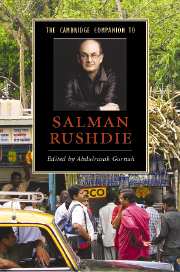2 - Rushdie and Bollywood cinema
from Part I: - Themes and Issues
Published online by Cambridge University Press: 28 November 2007
Summary
‘nobody from Bombay should be without a film vocabularly’
Midnight's Children” / Any study of Rushdie remains incomplete, indeed deficient, if not seen through the literature of migration and cinema. To read Rushdie through these - demographic shift and artistic form - simply means that we are more likely to get our understanding of him right than if we do not. The fact of diaspora, of the trauma of migration, explains many facets of Rushdie's reading of culture: his emphasis on the mongrelisation of our lives, delight in the chutnification of history, and importance given to the moment when 'newness' enters the world. Indeed, some, like Timothy Brennan, have found Rushdie's anti-nationalist, non-foundational reading of the nation state particularly prescient. The fact of cinema explains a number of matters of representation in the Rushdie corpus which without an understanding of cinema would be lost. Given the brief of this chapter, though, we may want to set aside the theme of migration and diaspora, referring to it only in as much as it impinges on our reading of Rushdie's engagement with cinema, in particular Bollywood/Bombay cinema.
When Rushdie writes about Indian urban culture as a culture 'full of fakery and gaudiness and superficiality and failed imaginations' but also full of 'high vitality, linguistic verve' and metropolitan excitement, he reads Indian urban culture through the eyes of his beloved Bombay and its dominant art form, the Bollywood cinema. The homage to Bombay and its cinema began early as is evident from Rushdie's tribute to The Wizard of Oz. We note that Rushdie saw the film at the Metro Cinema in 1957 at the age of ten, a crucial age at which he also saw, as it seems from his novels, two Bollywood films which had a decisive influence on him: Shree 420 ('Mr 420', 1955) and Funtoosh ('The Madhatter', 1956). Metro Cinema, now decrepit, is at the corner of First Marine Street (Anandilal Podar Marg) and the Esplanade (Mahatma Gandhi Road), next to Cinema Lane and not too far away from the Dhobi Talao area.
- Type
- Chapter
- Information
- The Cambridge Companion to Salman Rushdie , pp. 11 - 28Publisher: Cambridge University PressPrint publication year: 2007
- 1
- Cited by

